Feature Interview with Nick Edmund
September, 2020
1. What is your background? How did you come into golf?
I was born in Exeter, in south west England, in 1960 and spent my first 11 years enjoying a blissful stone-skimming (or rock skipping as I think you say) childhood growing up in ‘Glorious Devon’. The 1970s took me to Manchester, and it was during the early part of that decade that I fell in love with golf. It was something of a ‘chance acquaintance’ since none of my family had ever played. I remember being transfixed watching Tom Weiskopf win the 1973 Open at Troon on television, and soon afterwards feeling similarly mesmerised by images of the Kings and Queens Courses at Gleneagles. Three years later I attended my first Open at Royal Birkdale – Johnny Miller ultimately triumphed but, from that moment to this, Seve Ballesteros became my golfing hero.
I went to University in Bristol and qualified as a barrister in London. I began practising as a criminal lawyer and thought I was heading for a lengthy legal career … until someone seduced me into writing a golf book.
2. What/when was your first golf writing assignment?
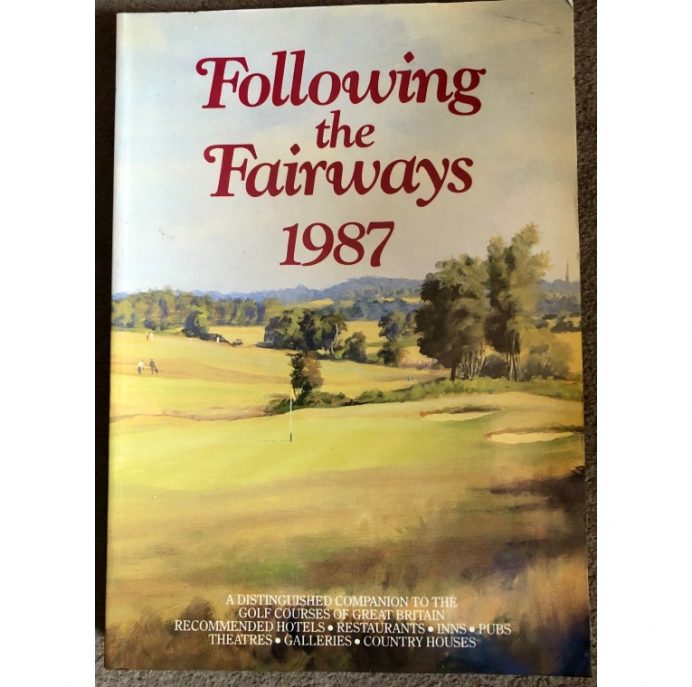
That golf book – the 1st edition of Following the Fairways, published in 1987 – was my first ‘assignment’ … A very entrepreneurial friend from university had set up a publishing company while still in his early 20s which quickly produced a best-selling guide to Great Britain’s (horse) race courses called Travelling the Turf. He felt the book’s format could be suited to other sports too, particularly golf. Having shared a house with me in Bristol he knew about my obsession with golf courses and, being a bit of a gambler, took a punt by asking me to help him create (and for me to write/edit) the proposed golf book. At the time I accepted the offer my thinking was, ‘Well, I’ll just take a year away from law; I know this book is going to be published and I’m only 26 so what have I got to lose?’
Following the Fairways, like its big sister Travelling the Turf, became an annual (14 editions were published). I was soon invited to produce/write other golf books and when I also became involved in golf destination marketing the chances of me ever returning to law gradually receded. I often joked that I decided to ‘swap The Bar for the 19th hole’; but in truth, as with much of life, it wasn’t planned.
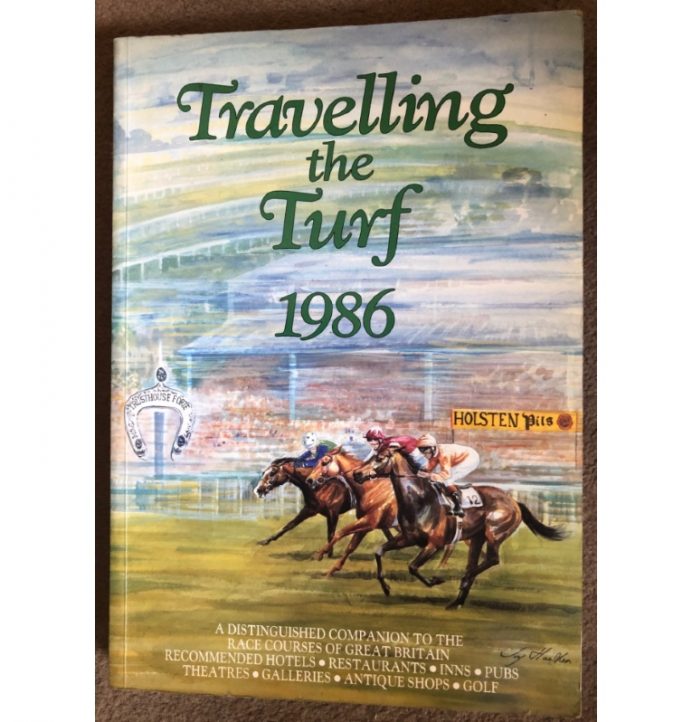
3. How did you learn to write so beautifully? You manage to combine a passion for the sport with an analytical eye to the point where I can I still vividly recall your article that made Walton Heath leap off the pages. How did you learn to break down courses so effectively?
I talked of ‘falling in love with golf’ in response to your first question, and you’ve just used the word ‘passion’ … I’ve long had an interest in many aspects of the game: as a teenager, in addition to playing from dawn ’til dusk during school holidays, I used to devour golf magazines and when I was about 14 I read all the PG Wodehouse golf stories. At some point I became particularly fascinated by golf courses – with the great diversity (and often beauty) of their locations and with the various features that made some more special than others.
4. What was the ‘mission statement’ of Following the Fairways?
Our goal was to create a very comprehensive as well as colourful and distinctive where to play and where to stay guide to the golf courses of Great Britain & Ireland: ‘informative golfing companion meets attractive easy-reading coffee table book’. We figured there were several golf guides in circulation – though they tended to be more akin to directories or manuals in terms of content and presentation and they included very little information about nearby accommodation, pubs, restaurants or other attractions; and of course, there were various books comprising course essays with plans and pictures of golf courses … However there was nothing that really combined ‘all of the above’.
5. The first edition stuck strictly to covering golf in Great Britain. When was Ireland eventually added?
You’re right – Irish courses weren’t included until the 2nd edition. For sure, I would have liked to have involved them from the outset, but first I had to visit the Emerald Isle! I find it hard to believe this now, given how much time I’ve subsequently spent in Ireland and how my experiences there have so influenced and shaped my life, but my first trip (to either the north or south of the island) didn’t occur until the late ’80s. Anxious to make up for lost time, the first three courses I visited and played were Royal County Down, Royal Portrush and Ballybunion. Needless to say, I thought I’d died and gone to heaven.
6. Whose decision was it to use fine art for illustrations? It certainly was a master stroke and made the editions quite handsome.
I couldn’t agree more … although I can’t claim any credit for that master stroke! The aforementioned Travelling the Turf included many superb fine art illustrations – horse racing is exceptionally blessed in that regard, and the publisher recognised that this was a feature that could similarly distinguish Following the Fairways and give it a USP.
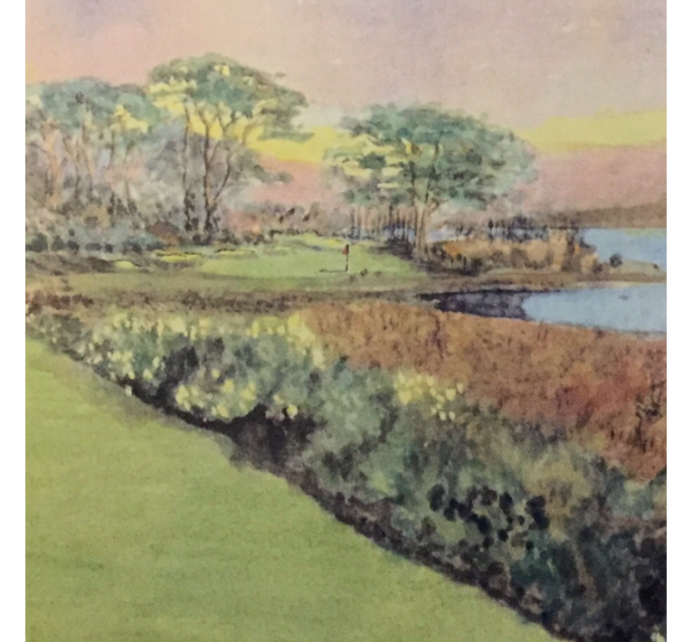
This is the sort of art work that helped make Following the Fairways standout.
7. Following the Fairways did its own course rankings. It was labeled the ‘100 Greatest Golf Courses’ but then it was broken up into 50 links and 50 inland/non-links courses. Was that your idea?
Yes, this one was my idea. Great Britain and Ireland possess an extraordinarily rich variety of golf courses. I think it’s hard enough comparing a parkland style course with a heathland, cliff-top or moorland type course – but links courses really are so different that I think it’s nigh on impossible to compare them with inland layouts. Where do you start in comparing a golf course like Wentworth or The K Club with a Dornoch, a Lahinch or a Hoylake?
8. How were those rankings determined? Were you the panel or did it consist of a number of voters? Were there any guidelines?
I‘m afraid I was ‘The Following the Fairways Panel’ – the judge and the jury … Of course, I consulted with people whose opinions I admired, plus in my defence I think it added another dimension to the book and we simply didn’t have the resources to create rankings that could realistically compete with those produced by the likes of Golf World and Golf Monthly. From a personal perspective, a big upside was that it ‘forced’ me into visiting most (in fact over the years practically all) of the leading courses throughout Britain and Ireland – so increasing my knowledge and appreciation of golf architecture.
9. In the March 1996 version, the top 6 links were – in order – St. Andrews, County Down, Ballybunion, Muirfield, Royal St. George’s, and Portrush. Hard to argue! Yet, in the 50 best Inland/non-links, five of the first ten courses were less than a decade old. Did the strong showing of such young courses surprise you given the strength of so many Golden Age heathland courses?
Looking back, I think I was trying to make a bit of a statement – namely, ‘there’s more to golf in Great Britain & Ireland than its famous old traditional courses’; and perhaps this was exacerbated by the fact that the ‘links list’ was inevitably comprised almost entirely of courses fitting that description. Maybe at the time I was also a little dazzled by the likes of Loch Lomond and Mount Juliet and, not yet having travelled quite so extensively, I believed some of the new GB&I courses to be more exceptional than they in fact are. So, do I now think the best 5 or 10 inland/non-links courses built between 1950 and 2000 are as good as the top 5 or 10 ‘Golden Age’ heathland courses crafted in the early part of the last century? No – but then the latter are masterpieces.
10. Another fascinating section was ‘The Best of Following the Fairways’ section which featured a potpourri of information from best par 3s/4s/5s to most scenic to hidden gems to ones with the most character/charm. Two favorite categories were Best Links/Non-Links under 6,500 yards (the winners in 1996 were St. Enodoc and West Sussex) and courses with the most character/charm (winners included Prestwick, Brancaster, Gleneagles and Royal Ashdown Forest). In 1996, North America was on a length fetish so seeing ‘shorter courses’ and ‘charming courses’ highlighted was a huge breath of fresh air. Who came up with these categories?
I’m glad you enjoyed that section and you’ve reminded me of the fun we had compiling those categories. The half-dozen courses you’ve just named: St Enodoc, West Sussex, Prestwick, Brancaster, Gleneagles and Royal Ashdown: what a wonderful collection – six of my all-time favourites!
You make a very good point with regard to ‘length fetish’. Moreover, I’m not sure the problem has gone away, or at least it now manifests itself in different ways. I think (and I believe most golfers think) it’s ridiculous how far the modern tour player hits the ball. I know the average amateur isn’t able to crush a drive 320 yards, and maybe courses in some parts of the world have the capacity to be lengthened, but most of our (GB&I) classic courses have already been stretched to their limit. If the trend isn’t reversed, in 20 years’ time none of those courses will be long enough to host major men’s events.

11. Finally, ‘Par for the Course’ made for more compelling reading, featuring everything from courses with castles to best restaurants and whiskey spots. Additionally, you provided the secretary and professional’s name and contact details, club addresses etc. Talk about a MONUMENTAL undertaking – surely that most have been exhausting?
It was indeed a considerable undertaking, but then as I’ve intimated it was also a labour of love. Unfortunately, our ‘Par for the Course’ research was more desktop than practical in nature, and the publisher wasn’t able to set aside any of the sponsorship monies to allow for exploring ‘courses with castles’ or visiting ‘best restaurants and whiskey spots’. Mind you, had such a budget been available, I’m sure he would have sent me to tour the castles while he inspected the distilleries!
12. What happened to Following the Fairways? How many editions were published in total? Did Wedgwood pull support at some point?
I think the digital age is what happened. From the mid-1990s golf clubs began to develop their own websites: initially most were fairly basic, but gradually they started to incorporate increasing amounts of descriptive detail as well as much of the contact and directory type information that made our book such an invaluable guide for golfers who enjoyed seeking out new courses.
Following the Fairways made it to the 21st century – the final edition was published in 2000/2001, by which time I had started to work with Faldo Design.
13. Restorations/renovations are a big deal on this side of the pond. In Great Britain and Ireland which links course and which inland course do you think have improved the most since Following the Fairways ceased publication in 2001?
Martin Ebert’s work at Turnberry and Portrush has significantly enhanced both of those great links courses and addressed what were their main weaknesses 20 years ago – in particular, Portrush’s (then) disappointing two finishing holes and the way the Alisa Course didn’t take full advantage of its dramatic coastline (the 9th for instance was one of the weaker holes in my opinion but now it’s one of the best).
A fairly substantial number of the leading links in Ireland have been renovated or redesigned since the turn of this century: Lahinch and Enniscrone immediately spring to mind as having been much improved, as well as the Old Links at Ballyliffin where Faldo Design was involved, so I accept I may be a little biased!
Perhaps the most controversial links redesign project in recent years has occurred at The Machrie on the island of Islay in south west Scotland. Long regarded as something of a cult links (or an anachronism depending on your point of view), when I played it in the 1990s the round included 17 blind shots. I thought it was great fun, not to mention a unique experience, so when I recently returned I was worried that I mightn’t like what I saw … but I‘m pleased to say I was very pleasantly surprised.
As for inland courses, again I think it’s good to highlight the ‘deforestation and resuscitation‘ activity that has taken place at a number of England’s best heathland courses, and I might pick St George’s Hill and Woodhall Spa as two of the finest.
14. There are some quite active threads on the GolfClubAtlas discussion board regarding the economic difficulties that many British clubs (outside of the very top tier of courses) are experiencing due to the pandemic and travel restrictions. Do you have any suggestions as to how clubs can adjust to a changing landscape to ensure their viability in the years ahead?
If I had the solution I would be applying for a global patent! It’s not easy is it, especially as at this moment we don’t know when normality or ‘near normal’ will return.
One thing I would like to see clubs encouraging more of – and it would help address slow play at the same time – is foursomes golf, or ‘alternate shot’ as I think you call it. The format suits ‘family golf’ and ‘close friends team play‘, so it responds to this age of needing to be careful who we mix with … I know it’s a format that’s never been popular in the US, but it was once common in Britain and Ireland, and if club members and their guests were incentivised to play this (perhaps with reduced guest and visitor fees and more foursomes competitions) then it might encourage more individuals and families to visit clubs, play a little more frequently … and spend more money in the process.
15. You managed Sir Nick Faldo’s course design business for fifteen years, from 1997 to 2012. What was that like?
It was an extraordinary experience. It was also, to use a slightly old-fashioned expression, an honour and a privilege. I am English, after all, and we are talking about Britain’s greatest ever golfer. As with Following the Fairways, I was fortunate to be there at the beginning. I think it’s fair to say that 1997 was the year Nick’s playing career started to wind down as he determined to devote an increasing amount of time to pursuing other interests – specifically the creation of the Faldo (Junior) Series and the launch of Faldo Design. I said it was an extraordinary experience, and I mean that for many reasons. For one thing it took me around the world – I visited amazing places and met remarkable people. We engaged some very talented architects and forged relationships with several inspirational partners.
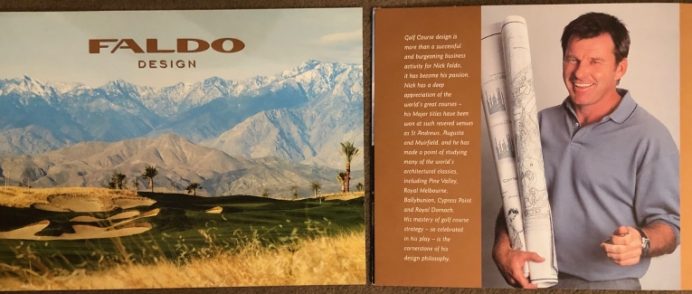
As MD I was responsible for winning new business as well as managing all contracts and relationships. But perhaps the most interesting aspect was developing and nurturing the business strategy … It was a team effort, and our aim was to harness Nick’s most distinctive personality traits – his attention to detail, strong convictions and general winning mentality, and integrate them with his defining strengths as a player: the ability to plan and plot his way around golf courses, his innate talent for visualising (and then executing) shots, and of course his mastery of course strategy.
16. Was there a particular project that stood out to you?
That’s a very difficult question. I think the achievement I’m most proud of is that we were able to win and then complete projects in every continent. We’d set out to create an international business and we succeeded. Of course, you also remember ‘the ones that got away’! In your April 2020 Feature Interview with architect Paul Jansen, who I had the pleasure of working with at Faldo Design, he touches on this – mentioning spectacular projects in Madeira and South Africa that were never completed; but then he also played a key role in the creation of outstanding layouts in Turkey and Vietnam.
If I had to pick my ‘favourite project’ then it would probably be our substantial remodelling of the Old Links at Ballyliffin in the far north west of Ireland, which I referenced above in question #13. But I’m not sure if it’s the project or the place that’s so special for me. I first met Nick Faldo in 1993 when he was at the peak of his career, and it occurred at Ballyliffin (I was marketing the club prior to its becoming a 36-hole facility with the opening of the Glashedy Links). Like me, Nick was especially enamoured with the extraordinary but natural terrain of the Old Links, so we were delighted when the club engaged Faldo Design a decade later … Moreover, I think Nick, working alongside his Lead Architect Guy Hockley, did a marvellous job in realising the links’ potential.
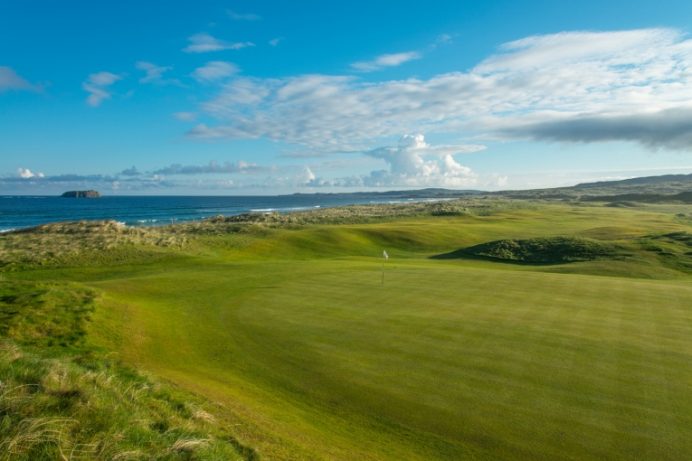
Faldo Design helped turn Ballyliffin Old and its rumpled land into one of Ireland’s top links.
17. Life doesn’t always go in the direction one hopes. When did you first get cancer?
In April 2014 a large lump appeared, seemingly ‘out of nowhere’, on the right side of my neck. It was quickly diagnosed as ‘head and neck cancer’ and I had emergency surgery on May 1st. This was followed by 6 weeks of intensive radiotherapy treatment. The cause of my cancer? Decades of over-exposure to the sun – not helped by the fact that I was born fair-skinned and red-headed.
I couldn’t know back then that my cancer would return three times in the next 5 years (on my forehead, extensively across my scalp and behind my left eye), leading to multiple surgeries, exactly 100 sessions of radiotherapy and a year-long immunotherapy trial; but I am fortunate to possess a very glass half-full approach to life and in 2014 I was able to look at the situation this way … I had reached my 54th year: the first 27 (1960-1987) were kind to me; I then got married in 1987 and greatly enjoyed the next 27 years – I have a wonderful wife, 2 fantastic kids (now young adults) and have had two careers involving golf and travel, my two biggest interests … So I figured that even if ‘the next 27 years or so’ were likely to be challenging with the prospect that cancer might curtail them, yes I should be concerned for others affected, but how could I feel sorry for myself? In ‘golf speak’ I was still 2 up with 1 to play.
18. You have beat it back twice since. When did you launch the Global Golf4 Cancer campaign? What does it strive to do?
The aim of the Global Golf4 Cancer campaign (www.globalgolf4cancer.org) is to encourage or inspire the golfing community to ‘fly the flag’ – literally at times – and support cancer fighters and cancer charities worldwide … The particular flag we invite clubs and event organisers to fly on their 4th hole (and just the 4th hole) on special occasions and at important events, is our distinctive Global Golf4Cancer ‘4-Flag’. The number ‘4’ is an especially significant number in both golf and cancer, and we view the 4-Flag as both an awareness symbol and a catalyst for fundraising.
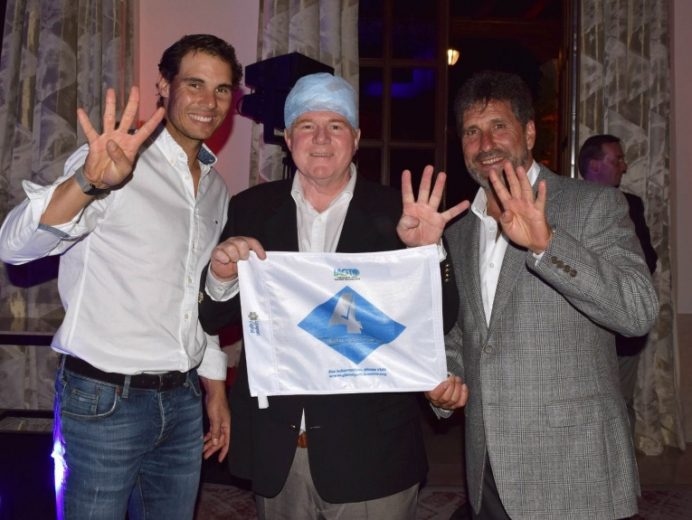
Two of Spain’s all-time greats join Edmund in a show of support.
Rather ironically, I had the initial idea in 2013, i.e. before I ever had cancer, but it wasn’t until 2016 that I was able to take the idea forward, and the campaign launched in early 2017.
19. You raised awareness for the cause by walking almost 1,200 miles around Ireland’s Wild Atlantic Way carrying your clubs. Tell us about that epic journey!
I wanted to launch Global Golf4 Cancer in an impactful way. I had developed many contacts and friends in Ireland through my golf writing and work with Faldo Design, and because of this, and for a few other reasons, I decided I’d commence the campaign there … I discovered there was a coastal road, evocatively called ‘The Wild Atlantic Way’ that began in the far north west of the country at Malin Head (not far from Ballyliffin) and ended in the far south west at the Old Head of Kinsale, close to Old Head Golf Links. In between, the route passed by the front gates of approximately 40 golf courses including the likes of Rosapenna, Co Sligo, Carne, Lahinch, Ballybunion and Waterville. I reckoned it would make a good story if I played the 4th hole at every course and personally presented a Global Golf4 Cancer 4-Flag to each club … And then I thought, wouldn’t it make a much more powerful story if I attempted to accomplish all of this on foot, carrying my golf clubs?
So, I set off from Malin Head on March 4th 2017 and ‘golf-walked’ my way to Old Head. It took 4 months and I did it in two stages; I finished by playing the 4th hole at Old Head – holing out on a green perched on bluffs 200 feet above the ocean with a lighthouse watching over. Sometimes I wonder how I managed to complete the journey, but I suppose a combination of the importance of the cause and the brilliant support received from family, friends and people throughout Ireland drove me forward – plus for some mysterious reason the wind always seemed to be blowing hard at my back!

The 4th hole at Old Head finishes near the base of the lighthouse. (Photo by David Cannon / Getty images)
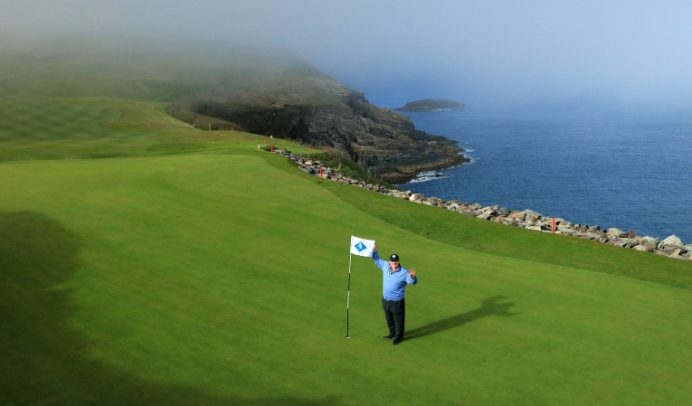
A happy Nick Edmund holds the 4th flag at Old Head.
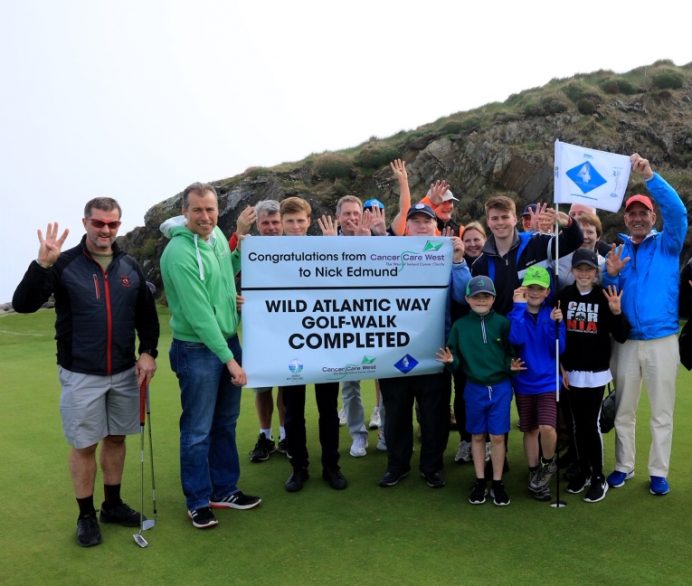
Wild Atlantic Way golf-walk completed!
20. Stepping onto the Swilcan Bridge with the two surgeons who saved your life is clearly an extraordinary moment. Additionally, your Global Golf4 Cancer flag has flown – literally – around the world on every golf continent. Does your mission ever end?
During the latter part of my Wild Atlantic Way golf-walk I decided I would undertake a second awareness-creating walk in Scotland … How could I fly the flag in Ireland but not in the Home of Golf? So in 2018 I golf-walked from ‘Turnberry to Dornoch via St Andrews’ – and again called into a collection of celebrated courses en route (25 of Scotland’s greatest links courses, including all the Open Championship venues), and raised the Global Golf4 Cancer 4-Flag at each.

Edmund commenced his Turnberry to Dornoch Scottish GlobalGolf4Cancer ‘4 flag’ campaign at Turnberry on October 15, 2018.
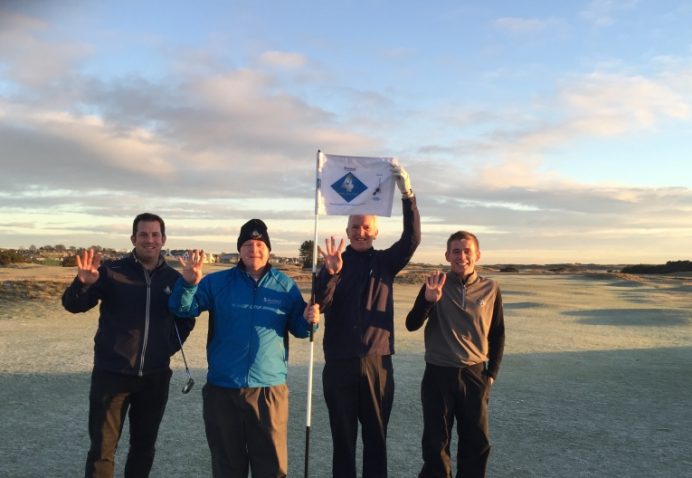
Clubs like Carnoustie Golf Club that support the campaign – initially by flying the GG4C flag on the 4th hole on special occasions as above – significantly adds to the program’s awareness. The date was, naturally, December 4th, 2018.

The walk was accomplished on December 22, 2018 when Edmund reached Dornoch, Scotland. (Photo by David Cannon/Getty Images)
The ‘Swilcan Bridge moment’ that you highlighted (November 30th, St Andrews Day) when my two surgeons flew up from London and walked with me to the Old Course, was indeed very special.

Sharing a moment with the two people that saved his life.
And yes, Global Golf4 Cancer has since become a genuinely worldwide campaign with the flag flying on 6 continents and at numerous iconic venues on significant dates and occasions. Our aim now is to have at least 400 of the world’s finest clubs involved by the end of 2021 (covid-19 notwithstanding). In the not-too-distant future, we plan to initiate some very distinctive fundraising events. I have a few ideas – some almost as crazy as golf-walking the lengths of Ireland and Scotland … but I think I’ll keep them up my sleeve for the time being!
21. Your illness has likely changed your perspective on life. What can you teach the rest of us who have not experienced such trauma and what were the things that enabled you to persevere?
Unquestionably my perspective on life has changed, and I think in many ways for the better: having had cancer 4 times has given me a much greater appreciation of what really matters and what’s not so important. You may find the following difficult to believe, but despite all the setbacks … imagine hearing (less than 3 years ago) that you need to have an entirely new scalp – an operation that is “far more serious” than the “life threatening” one performed on your neck 2 years earlier, and then to be told (just over a year ago now) that you are going to be blind in your left eye as a result of necessary treatment to your lower forehead because the cancer has returned and spread …. Despite all of this, the last 5 years have arguably been the best years of my life – the most meaningful and the most purposeful.
22. Beside a monetary contribution, how can our readers best facilitate your mission in the fight against cancer?
It’s kind of you to raise this; however before seeking your readers’ support in helping us to ‘fly the flag for cancer fighters worldwide’? I have a favour to ask of everyone … When you have a moment, please visit our website (www.globalgolf4cancer.org) and watch either the 5 minute ‘St Andrews video‘ that’s on the Home Page, or the 5 minute ‘Portrush video‘ that’s on the Our Mission page … or perhaps both … As you’ll see, after all these years I’m still ‘following the fairways’ – albeit in a slightly different way.
The End

